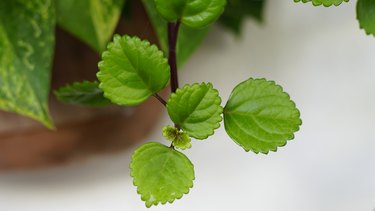
Quick-growing Swedish ivy (Plectranthus verticillatus), native to South Africa (not Sweden!), is a frost-tender perennial that thrives inside homes and as a hanging plant in sheltered gardens. Several Plectranthus types share the same common name of "Swedish ivy" with several unrelated species. Hardy in partial shade (a necessity when planted in hanging baskets or flowerpots outdoors), Swedish ivy thrives in USDA plant hardiness zones 10 and 11.
Swedish Ivy Basics
Video of the Day
Approximately 350 species make up the Plectranthus genus, part of the mint family (Lamiaceae), which includes coleus and Swedish ivy (though not true ivy, which is a different family entirely). When purchasing a Swedish ivy plant, it might be labeled as creeping Charlie, Swedish begonia, money plant, Plectranthus australis or Plectranthus forsteri. True creeping Charlie plants (Pilea nummulariifolia) are somewhat similar, but their leaves appear puffy and crinkled when compared to Swedish ivy leaves.
Video of the Day
Swedish ivy is a perennial in USDA zones 10 and 11 and can be used as a year-round ground cover by growers in those climates. In the rest of the country, it won't survive in your garden and is grown as an attractive, low-maintenance houseplant instead.
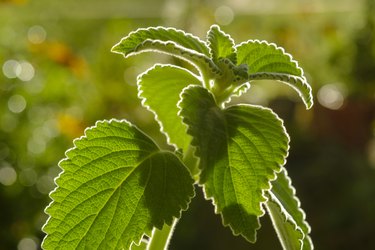
Dark green or purple semisucculent branches hold smooth 1 1/2-in.-wide oval to round leaves with toothed edges. The cultivar Variegata, also called marbled or variegated Swedish ivy, has green foliage edged in white. The small blue, purple or white flowers appear on up to 8-in.-long clusters at any time during the year. While the younger stems are erect, as branches grow longer, they begin to trail over the edges of flowerpots.
How to Propagate Swedish Ivy
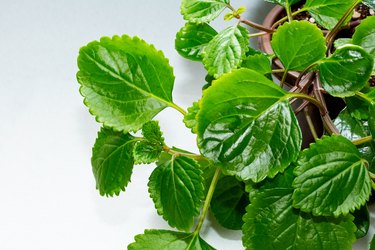
Swedish ivy is one of the easiest houseplants for beginners looking to practice their propagation skills because it roots reliably in either water or potting soil. If you have multiple ivy plants already, choose the healthiest plant to propagate from. The process is straightforward regardless of how you choose to root your cuttings.
1. Take cutting
Take stem cuttings in spring or fall for best results. The closed indoor environment makes houseplants susceptible to disease spread, so you should sterilize scissors or pruners in rubbing alcohol before taking the cuttings. It's also important to wash your hands or put on disposable gloves.
Snip a 3- to 5-in. stem from the plant just below a leaf node. In general, choose a thinner stem, as it will root easier than a thicker stem. If the parent plant is still fairly small, a 2- to 3-in. tip cutting taken from a healthy stem will suffice for starting in perlite or a sterile potting mix.
Tip
Whether rooting in water or a potting mix, remove leaves on the bottom two-thirds of the stem. Swirl it in rooting compound if you wish. Swedish ivy roots beautifully without it, but there’s no harm in stacking the deck in your favor.
2. Start ivy in water
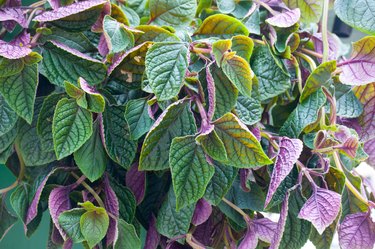
Swedish ivy is one of the best plants to propagate in water. Begin by mixing a sterilizing solution of one part bleach to nine parts water. Submerge the cutting in one portion of the same bleach solution for 10 minutes (again, to prevent transmission of diseases). Rinse well and allow it to air dry. While it's drying, wash your planting container and then use the remaining bleach solution to sterilize it.
Fill the container with clean, room-temperature water and place the cutting inside. If any leaves are below water, remove the cutting, pinch off the leaves and reinsert. Place the container in a warm location with bright, filtered light or indirect sunlight. Change the water every three to four days (or sooner if it becomes cloudy).
Roots should appear within one to two weeks. Allow roots to develop for another week and then plant in a well-draining potting mix.
3. Sprout ivy in soil
Sterilize a small flowerpot in a bleach and water solution. Rinse and air dry. Fill the pot with a moist potting mix or create your own mix by combining equal parts coconut coir or peat moss, compost and perlite. Moisten thoroughly and then use a pencil to make a hole in the mix.
Insert the cutting and press the mix around the stem. Cover the entire pot and cutting with a plastic bag or plastic or glass cloche. Place it in bright, filtered light or indirect light. Water occasionally to keep the potting mix moist but not waterlogged, as root rot can become a problem if you're overwatering.
When new growth appears, remove the cover. Keep the new plant out of drafts in a warm location. Transplant into a larger container when the plant outgrows its smaller flowerpot.
Plant Care Tips for Swedish Ivy
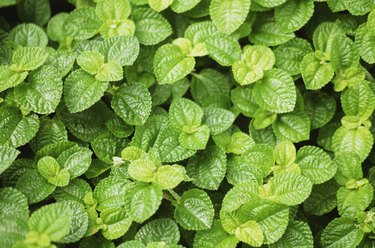
- Water Swedish ivy when the soil is dry to the touch. Don't allow the pot to dry out completely. Hanging plants on a patio may require daily watering in hot weather.
- Fertilize every two to three weeks when the plant is actively growing in spring and summer. Apply a balanced 20-20-20 liquid fertilizer according to the manufacturer's directions. Stop fertilizing in winter; let the plant rest.
- Pinch back stems as needed to keep the plant compact and bushy. Use trimmings for propagating Swedish ivy plants for the house or to share with family and friends.
- Mealybugs and spider mites are the most common threats to indoor plants, but treating infected Swedish ivy with an insecticidal soap will usually limit damage and prevent pests from spreading.
With these tips, you'll be growing, propagating and appreciating Swedish ivy in a snap!